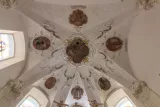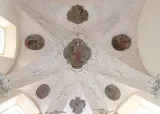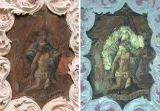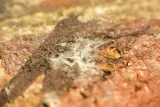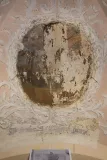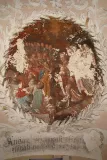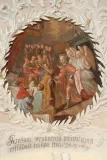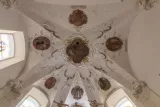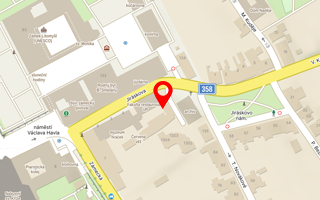Carried out by: Verena Fialová, Eliška Miklovičová, David Svoboda, Adéla Škrabalová (4th-year students of the Bachelor’s degree programme) and MgA. Lenka Slouková
Teaching supervision: Mgr. art. Jan Vojtěchovský, Ph.D.
St. Wenceslas side chapel, oriented towards the south, is part of the Klokoty Baroque Church of the Assumption of the Virgin Mary. The whole building is located within the pilgrimage compound built in the first half of the 18th century. In 2016, complete restoration treatment of the wall paintings located on the vault of the chapel and the victory arch at the entrance of the chapel was executed. It was preceded by a restoration survey (following the previous restoration works of 2012-2015). In the chapel dating back to 1712, the scenes of the Czech patron saint, St. Wenceslas’s life are depicted in stucco frames. They are based on the Legend of St. Wenceslas. The scenes depicted are St. Wenceslas’ education, St. Wenceslas has pagan godlings torn down and Christian churches erected, St. Wenceslas serving as an acolyte during a mass, St. Wenceslas sows, reaps and threshes corn, St. Wenceslas accompanied by angels come to the dukes’ assembly and St. Wenceslas as the protector of the Czech army. At the top of the vault, there is a more extensive central painting in a stucco frame depicting the scene of St. Wenceslas Murder.
The remaining areas of the vault are richly decorated with stucco figural and vegetative motifs. On the victory arch, seven wall painting medallions depict the Passion of the Christ scenes, which are part of the Marian cycle painted on the other victory arches in the church. The scenes include Christ says farewell to the Virgin Mary and the disciples, Christ on the Mount of Olives, Flagellation of Christ, Christ Crowned with Thorns, Jesus is Stripped of His Garments, Crucifixion and Pieta. The paintings on the arch are also surrounded by stucco frames. The paintings on the victory arch were not probably painted by the same artist as those on the vault, but the painters are unknown in both cases.
Based on the surveys, the way of execution was identified – most likely, it was painting with pigments bound with an organic binder, perhaps drying-oil-based. The paintings in the stucco frames on the vault were applied on bolus support, typical of Baroque canvas or panel paintings. From the detailed work and the technique used, we can judge that the artist was more likely an experienced painter of easel paintings than wall paintings.
Given the secondary overpainting that covered almost all the surface, the legibility of the original paintings is very low. The overpaintings were applied in two layers. The older secondary paint layers exhibit the greasy (oil) nature of the binder, while the later alterations are most probably executed in tempera.
The technical execution of the secondary intervention originating in the 1970s is of inferior quality; mainly in the sections on the vault, it could have considerably altered the visual appearance of the original subject matter. The surface of the paintings is covered with a thick layer of dust deposit and resistant greasy layer (probably soot produced by candles or oil lamps). The original painting carries damage such as craquelure; there are individual partial or total losses of adhesion of the paint layer to the support, flaking, biological growth, cracks in the plaster layers at individual places where cavities occurred. Invasive probes uncovered parts of inscriptions on the surrounding stucco decoration executed in lime secco technique.
The findings gained in the art-historical, restoration and microscopy surveys, tests and consultations with the National Heritage Institute representatives and the monument owners were considered as well as the concept of the restoration works carried out in 2012-2015. Finally, a decision was made to remove all the unoriginal layers even though there were extensive losses of the original paint layer. The conclusion was drawn with respect to the overall appearance of the monument as the secondary additions (later secondary interventions in paintings, stucco and walls) did not show sufficiently good technical and aesthetic condition. Another critical factor was discovering graphic sheets that served as reliable subject matter crucial for the reconstruction.
The overpaintings in the painted figural scenes on the vault and the victory arch of the chapel were entirely taken off. After a few steps of the necessary conservation treatment, imitative retouching and reconstructions were carried out to reach the overall unity of the painting form and contents. The retouches and reconstructions were executed using less intense colours and details and were carried out in two steps: at first, the scenes were retouched first with water-soluble and easily reversible water colour, which lay bases of the final retouches and reconstructions executed with oil-resin paints in the second phase. The selected method of retouching improved the reversibility of the intervention and reduced the risk of darkening of the oil-resin paints. The newly-discovered inscriptions were retouched and reconstructed with reversible water colour bound with Arabic gum.
